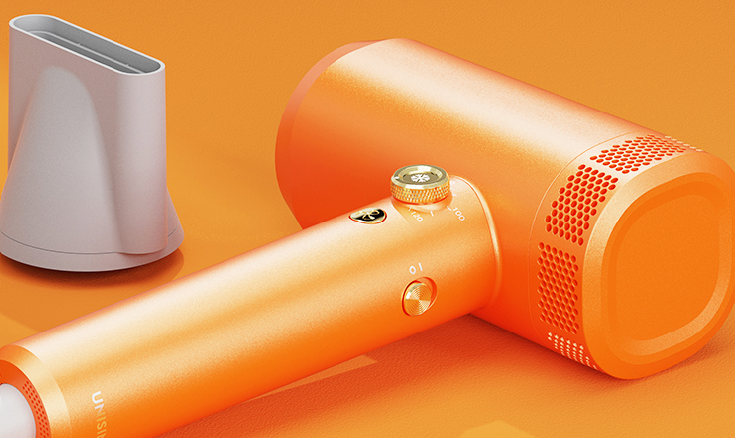
Leave your message and you’ll get:
● 24*7 online service support ● Articles in the hair dryer industry ● Sometimes maybe Discount

● 24*7 online service support ● Articles in the hair dryer industry ● Sometimes maybe Discount
Time:2023-10-21 Views:2

The hair dryer is directly driven by an electric motor to drive the rotor to rotate the fan blades. When the fan blades rotate, air is sucked in from the air inlet, and the centrifugal airflow formed by this is then blown out by the front nozzle of the air duct. When air passes through, if the heating wire installed on the heating bracket in the air nozzle has been electrified and heated, it blows out hot air; If the selection switch does not energize the heating wire to generate heat, then cold air is blown out. A hair dryer is used to achieve the purpose of drying and shaping. The selection switch on the handle of the hair dryer is generally divided into three positions, namely off position, cold air position, and hot air position, and is accompanied by indicator signs in white, blue, and red colors. Some hair dryers also have a motor speed control switch on the handle for selecting the size of the air volume and the temperature of the hot air. Various types of hair dryers are equipped with a rotating circular air conditioning cover on the back or side of the casing. By rotating the cover to adjust the cross-sectional size of the air inlet, the conveying wind speed and hot air temperature can be adjusted.
According to usage, there are handheld and pedestal hair dryers. The stand style hair dryer can be placed on a table or hung on a wall for use, and you can blow it yourself. According to the air supply method, there are centrifugal hair dryers and axial flow hair dryers. The centrifugal type relies on an electric motor to drive the fan blades to rotate, allowing the air entering the hair dryer to obtain inertial centrifugal force and continuously exhaust outward. Its disadvantage is that not all the exhaust air flows through the motor, resulting in a higher temperature rise of the motor; The advantage is low noise. The axial flow motor drives the fan blades to rotate, pushing the air entering the hair dryer to flow axially and continuously exhaust air outward. Its advantage is that all the discharged air flows through the motor, which has good cooling conditions and insulation that is not prone to aging; Its disadvantage is that it is noisy. According to the material used for the shell, there are metal type hair dryers and plastic type hair dryers. The metal hair dryer is sturdy and durable, and can withstand high temperatures. Plastic hair dryers are lightweight and have good insulation performance, but they are prone to aging and have poor high-temperature resistance.
1. Shell. It plays a protective role on internal components and is also an external decorative component.
2. Electric motor and fan blades. The motor is installed inside the casing, and the fan blades are installed on the shaft end of the motor. When the motor rotates, air is drawn in from the air inlet and blown out from the air outlet.
3. Electric heating element. The electric heating element of the hair dryer is wound with an electric heating wire and installed at the air outlet of the hair dryer. The air discharged by the motor is heated by the electric heating wire at the air outlet, which becomes hot air and is sent out. Some hair dryers are equipped with a thermostat near the electric heating element, which cuts off the circuit when the temperature exceeds the predetermined temperature, providing protection.
4. Wind deflector. Some hair dryers have circular windshields at the air inlet to regulate the air intake. A hair dryer without a circular wind deflector can also adjust the air intake by covering a portion of the air intake with a piece of paper. When the air intake is low, the air blown out is relatively hot, while when the air intake is high, the air blown out is not too hot. Please note that the air outlet should not be blocked too much, otherwise it may damage the motor or burn out the electric heating element due to excessive temperature.